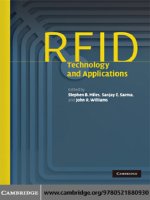multiple emulsion technology and applications
Bạn đang xem bản rút gọn của tài liệu. Xem và tải ngay bản đầy đủ của tài liệu tại đây (3.6 MB, 355 trang )
MULTIPLE EMULSIONS
TECHNOLOGY AND APPLICATIONS
Edited by
Abraham Aserin
WILEY-INTERSCIENCE
A John Wiley & Sons, Inc., Publication
MULTIPLE EMULSIONS
MULTIPLE EMULSIONS
TECHNOLOGY AND APPLICATIONS
Edited by
Abraham Aserin
WILEY-INTERSCIENCE
A John Wiley & Sons, Inc., Publication
Copyright © 2008 by John Wiley & Sons, Inc. All rights reserved
Published by John Wiley & Sons, Inc., Hoboken, New Jersey
Published simultaneously in Canada
No part of this publication may be reproduced, stored in a retrieval system, or transmitted in
any form or by any means, electronic, mechanical, photocopying, recording, scanning, or
otherwise, except as permitted under Section 107 or 108 of the 1976 United States Copyright
Act, without either the prior written permission of the Publisher, or authorization through
payment of the appropriate per-copy fee to the Copyright Clearance Center, Inc., 222
Rosewood Drive, Danvers, MA 01923, (978) 750-8400, fax (978) 750-4470, or on the web at
www.copyright.com. Requests to the Publisher for permission should be addressed to the
Permissions Department, John Wiley & Sons, Inc., 111 River Street, Hoboken, NJ 07030,
(201) 748-6011, fax (201) 748-6008, or online at />Limit of Liability/Disclaimer of Warranty: While the publisher and author have used their best
efforts in preparing this book, they make no representations or warranties with respect to the
accuracy or completeness of the contents of this book and specifically disclaim any implied
warranties of merchantability or fitness for a particular purpose. No warranty may be created
or extended by sales representatives or written sales materials. The advice and strategies
contained herein may not be suitable for your situation. You should consult with a professional
where appropriate. Neither the publisher nor author shall be liable for any loss of profit or any
other commercial damages, including but not limited to special, incidental, consequential, or
other damages.
For general information on our other products and services or for technical support, please
contact our Customer Care Department within the United States at (800) 762-2974, outside the
United States at (317) 572-3993 or fax (317) 572-4002.
Wiley also publishes its books in a variety of electronic formats. Some content that appears in
print may not be available in electronic formats. For more information about Wiley products,
visit our web site at www.wiley.com.
Wiley Bicentennial Logo: Richard J. Pacifico
Library of Congress Cataloging-in-Publication Data:
Multiple emulsions : technology and applications / edited by Abraham Aserin.
p. cm.
Includes index.
ISBN 978-0-470-17093-9 (cloth)
1. Emulsions. 2. Emulsions (Pharmacy) I. Aserin, Abraham.
TP156.E6.M84 2008
660′. 294514—dc22
2007019893
Printed in the United States of America
10
9
8
7
6
5
4
3
2
1
CONTENTS
Preface
vii
Introduction
xix
Contributors
xxiii
1. Multiple Emulsion Stability: Pressure Balance and Interfacial
Film Strength
1
Jim Jiao and Diane J. Burgess
2. Structure and Rheology of Stable Multiple Emulsions
29
P. Perrin, F. Prigent, and P. Hébraud
3. Visualization of Stability and Transport in Double Emulsions
45
Louise Braud Lawson and Kyriakos Papadopoulos
4. Effect of an Oil-Insoluble Solute on the Stability of
Multiple Water-Oil-Water Emulsions
67
Mouhcine Kanouni and Henri Rosano
5. Multiple Emulsions Stabilized by Biopolymers
85
Rachel Lutz and Abraham Aserin
6. Recent Developments in Manufacturing Particulate Products
from Double-Emulsion Templates Using Membrane and
Microfluidic Devices
121
Goran T. Vladisavljevic´ and Richard A. Williams
7. Recent Developments in O/W/O Multiple Emulsions
165
Axel Benichou and Abraham Aserin
8. Potentialities of W/O/W Multiple Emulsions in Drug Delivery
and Detoxification
209
Jean-Louis Grossiord and Moncef Stambouli
9. Surface-Modified Fine Multiple Emulsions for Anticancer
Drug Delivery
235
Ajay J. Khopade and N. K. Jain
v
vi
CONTENTS
10. Application of Emulsion Technology to Transarterial Injection
Chemotherapy for Hepatocellular Carcinoma Using
Double-Emulsion Enclosing Vesicles of Anticancer
Drug Solution
257
Shushi Higashi
11. Lipiodol W/O/W Emulsion for Transcatheter Arterial
Embolization Therapy Prepared with Two-Step Pumping
Emulsification Method
275
Tomoaki Hino and Takayuki Ohwaki
12. Multiple Emulsions: Delivery System for Antigens
293
Asuman Bozkir and Ongun Mehmet Saka
Index
307
PREFACE
In Honor of Prof. Nissim Garti’s 60th Birthday
In 2006, Prof. Nissim Garti celebrated his sixtieth birthday. By that time he
had had a brilliant scientific career spanning more than thirty-five years. No
happier way can be found of celebrating a scientist’s birthday than by issuing
a Festschrift in his honor. Such a Festschrift—be it a special issue of a journal
or a book—generally contains studies that intend to reflect various topics
relating to the putative extensive work and all-round interests of the honoree.
Usually only one Festschrift is issued on a particular anniversary. Nissim has
justly been awarded two Festschrifts!
The first was a special issue of a scientific journal.1 The intervening year
before the publication of the present book has served only to enhance the
renown of this outstanding scientist and to increase the fervor and esteem with
which this tribute is offered.
Between the covers of this book are published articles written by colleagues, alumni, and friends in honor of Prof. Garti. They are all one in their
affection and esteem for his personality and achievements. Many more would
have contributed but for space and schedules. Yet all join us in congratulating
Prof. Garti on passing his sixtieth birthday and on amassing a lifetime of work
vii
viii
PREFACE
and ground-breaking benchmark accomplishments as one of the most original
and innovative scientists in the field of surfactant chemistry.
Whereas the literature cited at the end of this Preface demonstrates ramified and diverse research areas—almost every one of which has long interested
Prof. Garti—the present book is focused on one subject: multiple emulsions.
This topical choice for the Festschrift reflects a challenging area to which
Nissim has devoted his talent and efforts over the past two decades, an area
in which he pioneered creative ideas and spearheaded and opened up new
far-reaching vistas. It is, I trust I may say, the hope of all contributors to this
book, that besides being our humble tribute to Prof. Garti, it may stimulate a
few readers to pursue the investigation of multiple emulsions.
Before delving into some of the most prominent works of Prof. Garti, it is
apposite to say something here about Nissim—the man and scientist. In
describing the biography of a distinguished scientist, there is always the challenge of balancing the personal aspects with the professional accomplishments.
The reader is referred to the Preface of the first Festschrift for a biographical
sketch of Prof. Garti, which offers a testimony to his eminence in various facets
of surfactant chemistry.
It would not be in accord with Jewish ethics to tell all of a man’s praise in
his presence—it can be done only in part. This brief Preface is therefore not
the place to expand on the personal characteristics of Nissim and the more so
as some of them were detailed at the end of this Preface.
However, it is still worth reiterating Professor Garti’s deep love for teaching. We know that Nissim, who is not capable of patting himself on the back,
will do anything he can to evade premeditated questions intended to highlight
his remarkable scientific career. Yet, were we to ask Prof. Garti what would
best characterize his life’s work, then, modest as he is about his multifarious
achievements, he would undoubtedly prefer to emphasize that at heart he is,
first and foremost, a teacher.
Presumably two reasons underlie Prof. Garti’s devotion to the arduous task
of education. First, learning was prized in Nissim’s household, his parents striving to imbue their children with a yearning for enlightenment. Nissim still
remembers that no sacrifice—including the carefree joys of childhood—was
too great in the pursuit of learning. Second, Nissim has a deep and abiding
respect for the teachers who directed him toward the experimental sciences.
Perhaps these two reasons led Nissim to develop a commitment to the teaching profession.
In the Preface of the first Festschrift, we have elaborated on the inferior
status of the teacher, on the way experimental work has to be done, and on
the assistance tendered by Nissim to colleagues and young scientists. In the
present Preface we would like to deal with two other points. First, we discuss
the seemingly contradictory method of Nissim’s teaching: Prof. Garti is considered a preeminent teacher, beloved by all his students without exception.
It seems prima facie rather paradoxical because, after all, Prof. Garti is a very
demanding and tough teacher, somewhat reluctant to give compliments or
high grades. So what is the magic of Nissim?
PREFACE
ix
It seems that Prof. Garti is the consummate pedagogue who teaches by
personal example. Few teachers have given more of themselves to their students than Nissim. He is never too busy to help young scientists, to give them
the gift of knowledge, how to proceed on the paths they had embarked upon,
always with kindness and a sincere interest in them and their work. Nissim
tries to help even low-performing students to cope with the myriad problems
they face in their scientific work on an almost daily basis. He provides his
assistance, sparing no effort and expecting no recompense.
He will juggle his hectic schedule in order to respond to others in need of
advice. He is always ready to put his personal library at his students’ disposal
and they say that his books are frequently of more value than those of the
university library. Any attempt to thank Nissim is usually a source of embarrassment to him. A teacher devoted to his students, Prof. Garti will not cancel
a single lesson even if it involves great inconvenience for him. Nissim’s students are impressed with his fairness and integrity, and with his scientific rigor
and intellectual grasp. Those who have passed through Prof. Garti’s hands can
appreciate his refusal to yield to perfunctory or superficial performance as
part of his instruction and research work. Above all, he invigorates his students
to launch and conduct their research projects, to raise the proper questions,
and to try to gain otherwise unavailable insights by employing innovative
measuring techniques. Prof. Garti teaches them repeatedly that investigation
yoked too tightly to a specific scientific model is almost always liable to fail.
They should therefore seek less trite approaches for their apparent insoluble
research problems. In a word, he encourages them to aspire to the highest
standards of scientific excellence.
The legacy of a scientist is usually measured in the number of his publications. Prof. Garti thinks that the contribution of a true scientist should be
valued via the students who came into his circle of influence, who learned from
him, and who would be ready to emulate his way even if it is difficult to follow
because of its high standards and exacting nature. We know, however, that
Nissim, even after meticulously checking and testing his experimental data and
their analysis again and again, always thinks that his work still lacks that perfection that would have been possible given more ample leisure. Indeed many
a potential scientific paper that could readily be published was postponed or
even abandoned by Nissim, since in his opinion just a certain minor point was
not sufficiently well-founded. This is the reason why Prof. Garti disdains what
might be called tawdry scientific methodology—hastily publishing premature
articles that rely on a maze of rather implausible hypotheses with only scant
experimental data behind them. Nissim asserts that it would have been salutary if the authors of such papers had noticed that in this way science does not
advance in the least.
Most educators have failed to study diligently how students use their knowledge and training in out-of-classroom (or lab) settings when these may be the
uses that matter most. Nissim, however, initiates his students not only into
careful research but also into the practical life of the professional. For example,
he instructs them how to acquire the competence and confidence to prepare
x
PREFACE
and submit articles for publication in scientific journals and how to see their
works properly through the publishing process, a task that without assistance
can be frustrating and discouraging even to a highly motivated student. Even
when Nissim himself writes the manuscript of a scientific paper, he feels that
every student who has participated in the research work is just as involved
and helpful in its completion and getting it published. Moreover Prof. Garti
would generously help students and colleagues with their own writing in order
to achieve clarity of exposition.
The second point relates to science education. The most widely claimed
goals of science education are: to produce citizens who are scientifically literate and to support citizens in understanding reports and discussions of science
(especially about issues that may be controversial) that appear in the popular
media. At the core of science education activity we find also two other tasks:
1. To attack pseudoscience beliefs and ideas that have been gaining ground
over the last two decades, mainly because of the entertainment
industry.
2. To improve the ability of the general public to distinguish between fact
and fiction, since the visual media have blurred the distinction between
these two concepts.
Nissim’s sense of concern and commitment to the furtherance of science
has always extended beyond his own students to include the “educated layman.”
So he does his best to achieve these goals.
As a part of his endeavor to bring academic interests and scientific achievements to a large audience and to widen the circle of informed readers and listeners, Prof. Garti is always ready to find time, whether to lecture on science
to interested groups or to write scientific articles in popular journals. Nissim
is endowed with an extraordinary blend of oratorical power and intellectual
acuity that, together with his infectious enthusiasm and eloquent writing,
almost inevitably enables him to imbue his listeners and readers with a keen
interest in science. Moreover Nissim also tries to direct their attention to
research findings that are rarely communicated to the general public directly
by scientists.
Such lectures or papers have to be prepared carefully and thoroughly.
Nissim knows how to elucidate points of cardinal significance and how to
translate from scientific language into something palpable and meaningful to
the “common person.” Indeed Nissim’s limpidity and economy of expression,
combined with the restriction of technical material to the minimum, enable
him to simplify intricate scientific topics.
Prof. Garti also knows how to whet the appetite of his audience for more
information. In lectures he succeeds in igniting the interest of his listeners by
utilizing highly entertaining and informative presentations communicated in
a voluble, exuberant style. Frequently he tells vivid stories about how science
works and about the strengths and frailties of prominent scientists. Far from
PREFACE
xi
least, these stories reveal the significance of scientific achievements more than
the usual dull reports. It should, however, be noted that Prof. Garti gets far
and away the best response from his listeners and readers when he teaches
them to be skeptical and to accept as truth only statements that are irrefutable
through scientific scrutiny.
Nissim’s solution to the prevailing problem of disgruntled listeners who
pester the lecturer with questions is very typical and instructive. Most lecturers
regard them as too clever by half and needing to be taken down a peg or
two. Prof. Garti always tries the opposite attitude toward these smart alecs.
Generally, he follows a two-pronged strategy. First, he would treat them with
considerable respect and tolerance, never being invidious or talking down to
them. Second, he would use his dry and witty sense of humor to relieve tension
during his lectures.
We now turn to the seminal contributions of Prof. Garti to the study of
multiple emulsions. Nissim’s research interests could never be limited to any
single scientific problem or theme, and this only becomes fully apparent upon
examining the scope of his over 300 refereed publications, invited symposia,
book chapters, and reviews. However, for Nissim, multiple emulsions have
been a favorite object of investigation ever since the early 1980s, and he has
become one of the most active scientists in this burgeoning area.
Moreover there is an interesting relation between Prof. Garti’s skills as a
scientist and teacher regarding multiple emulsions. It is known that persuading
students to be involved in multiple emulsions research is a formidable
educational challenge. Far be it for me to argue that such an investigation is
too difficult for a graduate student, since the underlying concepts in multiple
emulsions science are quite easy to grasp and yet experimental work on these
emulsions is undoubtedly one of the most demanding and enervating research
tasks students may encounter within surfactant chemistry. This is simply
because the continuous, long-term (in the order of weeks and even months!)
monitoring need for following up any changes in the multiple emulsion stability, and furthermore in the rate of addendum release, virtually confines the
student to the lab as long as such an experiment is going on. Nevertheless,
some students have been lured by Nissim’s enthralling descriptions of multiple
emulsions, and the main results of their M.Sc. and Ph.D. works are detailed in
the following.
These multi-compartment liquid dispersions are considered adequate
vehicles for controlled and sustained delivery of entrapped addenda, such as
drugs. Thus a drug that is dissolved or suspended in the internal aqueous phase
of a W/O/W emulsion is forced to diffuse across the oil phase prior to being
released into the body fluids.
Multiple emulsions have been the subject of numerous investigations due
to their importance as an emerging and promising technology for slow and
controlled release of active ingredients and as a major scientific challenge
regarding the preparation and improvement of the kinetic stability of these
inherently thermodynamically unstable entities. As a testimony to the
xii
PREFACE
evolution of the field of multiple emulsions, one may merely peruse the subject
matter of the articles in this book.
Prof. Garti maintains a preeminent position in the research of multiple
emulsions as is manifested by his nearly 40 articles concerning them. These
scientific papers exhibit the gripping combination—typical of Nissim’s research
work—of brilliant and ingenious insights together with rigorous treatment of
even the minutest details, which are acquired by hard and systematic experimental work.
Several highlights achieved by Prof. Garti are herewith outlined more or
less in chronological order.
In 1983 Nissim had already tackled the problem of how to overcome the
unpleasant taste of drugs such as chlorpromazine-HCl. Oral administration of
a bitter-tasting medication to a child is obviously a cumbersome task. The
solution suggested by Prof. Garti was to dissolve the drug in the inner phase
and to release it throughout the oil phase in the presence of synthetic gastric
juice. A child will swallow medication willfully when the outer water phase
contains synthetic flavors that simulate attractive tastes such as that of strawberry or raspberry. It should be noted that the drug release in this case is
neither controlled nor targeted.2
The release of electrolytes and drugs from multiple emulsions can, in principle, proceed via two possible mechanisms:
1. The oil layer separating the inner and outer aqueous phases behaves
as a semipermeable membrane: The release of solutes from a W/O/W
multiple emulsion, for instance, only occurs through breakdown of the
multiple droplets as a result of osmotic flow of water to the inner phase
and consequent coalescence of the droplets.
2. The oil layer behaves as a permeable membrane and the solute migrates
by diffusion from the inner emulsion.
Prof. Garti has shown3 that the diffusion mechanism is a predominant factor
in the migration of electrolytes from the inner to the outer phase in multiple
emulsions. The release of the electrolyte is affected by its hydrophobicity and
concentration but not by the viscosity of the internal phase.
In another paper, written in collaboration with D. Whitehill,4 it was
demonstrated that the addition of NaCl to multiple emulsions causes droplet
shrinkage due to loss of internal water. Micelle transport seemed to be the
primary mechanism.
A kinetic model, adapted from that of Higuchi for release of dispersed
drugs from polymeric matrices, was found to be suitable for the release of
electrolytes from multiple emulsions. The existence of a diffusion-controlled
mechanism was experimentally confirmed. This mechanism is facilitated as the
concentration of reverse micelles formed in the oil phase increases.5
In another investigation it was shown that whereas the presence of electrolytes in the outer aqueous phase has no bearing on the control of drug leaching
PREFACE
xiii
from the inner aqueous phase even when there is no osmotic pressure gradient
between the two aqueous phases—implying that the system is not controlled
solely by this factor—the presence of electrolytes in the internal water phase
can retard the drug migration. Electrolytes that can cause salting-in of the
emulsifier to the oil phase strengthen the oil–water interface and thereby
decrease drug transport.6
Additional milestones in Prof. Garti’s work regarding the stabilization of
multiple emulsions should be mentioned:
Solid oil (paraffin wax) is superior to liquid oil in formulations of multiple
emulsions as a stable rigid oil membrane is formed that hinders the migration
of additives from the inner water phase.7
Prof. Garti was among the first scientists to understand the significance of the
replacement of monomeric surfactants (usually blends of hydrophobic and
hydrophilic amphiphiles) by polymeric emulsifiers. Such multi-anchoring
macromolecules provide strong steric stabilization capabilities via the formation
of thick and flexible interfacial films. An early highlight of Nissim’s work in this
area comprises the utilization of polysiloxane-graft-poly(oxyethylene) to stabilize W/O/W multiple emulsions. Stable, small droplet size W/O emulsions were
formed with hydrophobic comb-grafted copolymers adsorbed at the inner interface. The outer interface of the W/O/W multiple emulsions was stabilized by
hydrophilic comb-grafted copolymers with similar structures but with highdensity grafting and long poly(oxyethylene) chains. The release rates of additives
from such multiple emulsions were very slow.8 Silicone-based surfactants impart
unusual mechanical stability to W/O/W multiple emulsions that makes them
possible candidates for slow release systems for agricultural applications.9
In addition to synthetically tailor-made polymeric amphiphiles, naturally
occurring biopolymers are considered for stabilization of multiple emulsions,
especially where these emulsions are needed for food and cosmetic applications. Thus the protein bovine serum albumin (BSA) significantly improves
the mechanical and steric stability of W/O/W emulsions when used in a blend
with a nonionic surfactant, such as Span 80. It is assumed that the two amphiphiles act synergistically by forming an interfacial complex—presumably a
thick, strong gelled film that confers resistance to rupture and elasticity on the
inner droplets. Based on Garti’s modification of Higuchi’s model, it was concluded that BSA has a double role:10
1. At the inner phase, BSA provides a mechanical barrier to the release of
small molecules from the internal interface. The release proceeds mainly
via reverse micellar transport. The presence of BSA reduces the chance
of reverse micelle formation and thus decreases the release rate of
entrapped addenda within the emulsion droplets.
2. At the outer phase, BSA impedes coalescence via steric stabilization.
Stable water in vegetable oil emulsions can serve as basic preparations for
food-grade W/O/W multiple emulsions. A novel way of stabilization of such
xiv
PREFACE
systems is to use submicronal α-form, crystallized hydrogenated fat (tristearin)
homogeneously dispersed in the oil phase.11 The crystals should be submicronal in size to effectively adsorb and accommodate at the interface. Large
crystals flocculate in the continuous oil phase.12 Yet these solid fat particles
cannot sufficiently stabilize the W/O emulsion, and they have to be blended
with a lipophilic surfactant (polyglycerol polyricinoleate, PGPR). The combination of fat microcrystals and PGPR has the following advantages:
1. Aggregation and flocculation processes are inhibited.
2. PGPR serves as a cross-linker or a bridge between the fat particles and
water.
3. PGPR facilitates the anchoring of the fat particles in the oil phase while
dangling itself in the water phase.
4. PGPR functions as an α-tending crystal structure modifier.
Improved stability can be obtained by utilizing the emulsifier PGPR in the
internal water phase and a protein-polysaccharide hybrid (as a substitute for
the common nonionic hydrophilic monomeric emulsifiers) in the external
interface. For instance, whey protein isolate (WPI) forms soluble complexes
with hydrocolloids such as xanthan gums or galactomannans at selected pH
values and weight ratios. These hybrids with specific interface recognition
capabilities stabilize multiple emulsions mainly via steric interactions at the
oil-water external interface. However, at high gum levels, the emulsions become
more elasticized, uncomplexed gum migrates to the bulk, and the depletion
mechanism will dominate. The stabilizing effect of such hybrids is synergistic.
Thus droplets of WPI/xanthan-based multiple emulsions are, respectively, onefourth or one-eighth smaller than those of multiple emulsions based solely on
either WPI or xanthan.13
Excellent stability to coalescence was obtained via interaction of WPI with
modified pectin.14
The effects of WPI/polysaccharide conjugates on the stabilization of multiple emulsions are the subject of recent studies. It was observed, for example,
that the release of vitamin B1, entrapped in the core of W/O/W multiple globules, is hampered due to the biopolymer adducts formed at the interface.15
Similar adducts stabilize O/W/O multiple emulsions and serve as efficient
barriers against release of addenda contained in the inner phase.16
In Prof. Garti’s opinion, employing multiple emulsions should not be
restricted to pharmaceuticals, nutraceuticals, and cosmetics. He hopes that
other promising and exciting applications will be available in near future. The
microencapsulation of fine boron particles in W/O/W multiple emulsions may
serve as such a feasible example.17
Last, the results of a very recent investigation concerning a novel type of
multiple emulsion, dubbed “emulsified microemulsion” (EME), are herewith
PREFACE
xv
shown. Since the kinetic stability of the internal phase is inversely proportional
to its droplet size, it is conceivable that nanosized droplets (microemulsions)
would improve the system stability. One potential application of such emulsified microemulsions is the formation of submicronal injectable liquid W/O/W
preparations for controlled drug release.
This concept has barely been implemented before now due to the tedious
experimental work necessary to ascertain that the nano-droplets remain intact
after the secondary emulsification stage as well as after prolonged storage.
Moreover the very fast exchange of the monomeric surfactants between the
internal and external interfaces induces concurrent emptying of the core phase
and leaching of the inner water phase.
This second problem has been solved skillfully in Prof. Garti’s lab by using
glycerol monooleate as surfactant, R(+)-limonene/ethanol 1 : 1 (by weight) as
the oil phase, and water/glycerol (9.15 : 0.85) (wt/wt) as the water phase.
Samples of this microemulsion were further emulsified, utilizing the hydrophobic graft copolymer Pluronic F127 (PEO99-PPO67-PEO99, where PEO stands
for polyethylene oxide and PPO for polypropylene oxide). Pulsed-gradientspin-echo NMR has shown that glycerol monooleate and R(+)-limonene are
present in the inner phase of the emulsified microemulsion even after the
second emulsification process. Electrical conductivity measurements have
demonstrated that at least 60 wt% of the internal water phase remained confined after the second emulsification stage. SAXS (small angle X-ray scattering) measurements have shown that the inner microemulsion in the emulsified
microemulsion is more ordered than the original L2-phase. This surprising
finding may be attributed to the effect of the polymeric surfactant. Cryo-TEM
(transmission electron microscopy) images of the emulsified microemulsion
provide direct evidence for the existence of spherical globules in the inner
phase, having a mean diameter of 250 ± 50 nm in rather good agreement with
corresponding results by DLS (dynamic light scattering): approximately
200 ± 50 nm, which is about 10 to 20 times smaller than the size of conventional
multiple emulsion globules. The investigated system has remained stable
during up to 12 months of storage at ambient temperature. This promising
system is now being studied to explore its ability to retain bioactive addenda
and release them in a controlled manner.18
It seems appropriate to conclude with a personal note. Prof. Garti is to me
a teacher and a mentor. The scope and magnitude of his influence on me are
without equal. As a senior member of Nissim’s research team, I have a daily
contact with him, and I would like to share some of my impressions with the
readers of this Preface. Prof. Garti is now at the pinnacle of his highly
variegated scientific achievements. As Nissim enters his seventh decade of
life, I can assure the readers that he has not yielded to the demands of age.
On the contrary, every year Nissim looks younger. None of his stamina has
been lost. His energy and willpower may be likened to an ever-flowing fountain and, more wonderful still, they show no signs of diminishing. Prof. Garti’s
xvi
PREFACE
enthusiasm for work, his alert response to new ideas, and his original insights
have remained unblemished and keen. He is always the first person to enter
the lab in the morning and the last to leave at night, filling his long day with
incessant activity.
Nissim never forgets to acknowledge that all his accomplishments and
success are due to his wonderful family and, most of all, to his wife, Ricki. She
has been standing by Nissim in joy and sorrow, always giving of herself without
stint to him and their family.
This Festschrift is herewith presented to you, Nissim, as a token of our heartfelt appreciation and admiration. The book is accompanied by our ardent
prayer that like our ancient leader, Moses, may “your eyes remain undimmed
and your vigor unabated.” It is the fervent hope of your friends, colleagues,
and students that you will enjoy good health and continuous creative labor for
many years to come.
Abraham Aserin, Ph.D.
LITERATURE CITED
1. Aserin A. 2006. Honoring Professor Nissim Garti. Adv Colloid Interface Sci (1–3):
128–130.
2. Garti N, Frenkel M, Schwartz R. 1983. Multiple emulsions. Part II: Proposed technique to overcome unpleasant taste of drugs. J Dispers Sci Technol 4(3): 237–252.
3. Magdassi S, Garti N. 1984. Release of electrolytes in multiple emulsions: Coalescence and breakdown or diffusion through oil phase? Colloids Surf 12: 367–373.
4. Garti N, Magdassi S, Whitehill D. 1985. Transfer phenomena across the oil phase
in a water-oil-water multiple emulsion evaluated by Coulter counter. 1. Effect of
primary emulsifier on permeability. J Colloid Interface Sci 104(2): 587–591.
5. Magdassi S, Garti N. 1986. A kinetic model for release of electrolytes from W/O/W
multiple emulsions. J Controlled Release 3(4): 273–277.
6. Garti N, Romano-Pariente A, Aserin A. 1987. The effect of additives on release
from W/O/W emulsions. Colloids Surf 24: 83–94.
7. Magdassi S, Garti N. 1986. Formation of water/oil/water multiple emulsions with
solid oil phase. J Colloid Interface Sci 120(3): 573–579.
8. Sela Y, Magdassi S, Garti N. 1994. Polymeric surfactants based on polysiloxanes—
graft-poly(oxyethylene) for stabilization of multiple emulsions. Colloids Surf A
83(2): 143–150.
9. Sela Y, Magdassi S, Garti N. 1995. Release of markers from the inner water phase
of W/O/W emulsions stabilized by silicone-based polymeric surfactants. J Controlled Release 33(1): 1–12.
10. Garti N, Aserin A, Cohen Y. 1994. Mechanistic considerations on the release of
electrolytes from multiple emulsions stabilized by BSA and nonionic surfactants.
J Controlled Release 29(1–2): 41–51.
11. Garti N, Binyamin H, Aserin A. 1998. Stabilization of water-in-oil emulsion by
submicrocrystalline α-form fat particles. J Am Oil Chem Soc 75(12): 1825–1831.
PREFACE
xvii
12. Garti N, Aserin A, Tiunova I, Binyamin H. 1999. Double emulsions of water/oil/
water stabilized by α-form fat microcrystalline particles. J Am Oil Chem Soc 76(3):
383–389.
13. Benichou A, Aserin A, Garti N. 2002. Double emulsions stabilized by new molecular recognition hybrids of natural polymers. Polymers Adv Technol 13(10–12):
1019–1031.
14. Garti N, Wicker L. 2005. Pectin methylesterase modified pectin interaction with
whey protein isolate and stability of double emulsions. Abstracts of Papers, 229th
ACS National Meeting, San Diego, CA, March 13–17, 2005, CELL-119.
15. Benichou A, Aserin A, Garti N. 2007. W/O/W double emulsions stabilized with
WPI-polysaccharide complexes. Colloids Surf A 294(1–3): 20–32.
16. Benichou A, Aserin A, Garti N. 2007. O/W/O double emulsions stabilized with
WPI-polysaccharide conjugates. Colloids Surf A 297(1–3): 211–220.
17. Berkovich Y, Aserin A, Garti N. 2004. Practical and mechanistic considerations in
the use of W/O/W double emulsions for microencapsulation of fine boron particles.
J Dispersion Sci Technol 25(1): 89–99.
18. Lutz R, Aserin A, Wachtel EJ, Ben Shoshan E, Danino D, Garti N. 2007. A study
of emulsified microemulsion by SAXS, cryo-TEM, SD-NMR and electrical conductivity. J Dispersion Sci Technol 28(8): forthcoming.
INTRODUCTION TO MULTIPLE EMULSIONS
TECHNOLOGY AND APPLICATIONS: AN UPDATE
When it was decided to compile a book in honor of Prof. Nissim Garti on the
occasion of his sixtieth birthday, choosing an appropriate topic was rather difficult. The diversity of topics investigated by Prof. Garti and his research group
in the surface chemistry field is simply amazing. A most conspicuous theme
among these topics is the area of multiple emulsions in which Nissim has
become a foremost authority. Moreover this attractive subject provides a good
prospect for much demand even if the technology is still waiting for a real
breakthrough.
Since William Seifriz described for the first time in 1925 these intricate
liquid systems having ternary, quaternary, or more complex structures that he
named multiple emulsions, the literature has been “flooded” every year with
tens of new examples demonstrating release patterns and control of active
ingredients using these systems. Multiple emulsions, at least in theory, have
significant potential in many applications because the internal droplets can
serve as an entrapping reservoir for active addenda that can be released by a
controlled transport mechanism. Many of the potential applications would be
realized in the fields of agriculture, pharmaceuticals, cosmetics, and food.
In practice, double emulsions consist of large and polydispersed droplets
that are thermodynamically unstable, with a strong tendency for coalescence,
flocculation, and creaming.
Efforts have been made to improve emulsion stability and to control the
release of active matter. Almost any possible blend of low-molecular weight
emulsifiers, oils, cosolvents, and coemulsifiers have been tested. The nonviscous
fluid multiple emulsions were always unstable. Only semisolid multiple emulsions, gelled or thickened systems, have long shelf-life and prolonged stability.
Biopolymers, synthetic graft and comb copolymers, and polymerizable emulsifiers impart steric or mechanical stabilization to the multiple emulsions and
significant controlled release of additives contained in them. Naturally occurring and synthetic macromolecular surfactants that increase the viscosity of
each phase of the multiple emulsion and form complexes with the emulsifiers
or the oil can lead to formation of systems that will behave much like microcapsules, microspheres, and mesophasic liquid crystals.
This book mostly stresses the recent findings that model the transport phenomena through the different interfaces present in multiple emulsions. It will
be useful for each formulator to understand how he can enhance the stability
xix
xx
INTRODUCTION TO MULTIPLE EMULSIONS TECHNOLOGY AND APPLICATIONS
of multiple emulsions. The achievements include (1) new theoretical approaches
and modeling to characterize the transport mechanism in multiple emulsions,
(2) droplet size reduction and increased shelf-life stability by using polymeric
amphiphiles and complex adducts, (3) use of new emulsification techniques to
enhance the monodispersibility of the droplets, and (4) potential applications
in drug delivery systems where clinical studies have already proved their
efficacy.
Thus the chapters, which have been contributed by leading authorities in
the field, are arranged logically in sections according to their increasing complexity: I—definitions and properties; II—formation and stability; and III—
potential applications with a special emphasis on medical and pharmaceutical
applications.
The first chapter by J. Jiao and D. J. Burgess discusses the thermodynamic
instability of multiple emulsions as a result of the excess of free energy caused
by the formation of the emulsion droplets. In multiple emulsions consisting of
three distinct liquid phases, counteracting the effect of the Laplace pressure
by electrolyte addition to the inner dispersed aqueous phase will increase the
destabilization of the system owing to osmotic pressure. In addition the authors
discuss the effects of both osmotic and Laplace pressure as well as the interfacial rheological properties of these complex systems and their stability.
In the second chapter P. Perrin, F. Pringent, and P. Hebraud describe the
structure and rheological properties of stable W/O/W multiple emulsions stabilized with polymeric surfactants. By operating confocal microscopy and diffusing wave spectroscopy, they were able to visualize and to study the dynamical
properties of the inner dispersed droplets.
The next chapter by L. B. Lawson and K. Papadopoulos is an overview of
microscopy techniques, including photomicrography, video micrography,
capillary microscopy, and electron microscopy, used to study the stability and
transport phenomena in multiple emulsions systems.
The fourth chapter by M. Kanouni and H. Rosano describes the effect of
an oil-insoluble solute on the stability of multiple water-in-oil-in-water emulsions. The authors build a theoretical model based on Laplace and osmotic
pressure to interpret the transport phenomena in multiple droplets.
Part II focuses on the formation and stabilization of multiple emulsions.
R. Lutz and A. Aserin in chapter five develop a new concept to stabilize
W/O/W multiple emulsions by using hybrids (complexes) of protein and polysaccharides that were shown to improve the stability of these complex systems
and to better control the transport of the entrapped addendum.
The next chapter by G. T. Vladisavljevic and R. A. Williams is a comprehensive and systematic review of new techniques of preparation of multiple emulsions, emulsions, and microparticles. The authors envisage the ways to form
multiple droplets by using membrane emulsification processes and microchannel and microcapillary devices. They also pay special attention to the preparation of solid microparticles via a double emulsion emulsification method using
membrane emulsification and microfluidic devices.
INTRODUCTION TO MULTIPLE EMULSIONS TECHNOLOGY AND APPLICATIONS
xxi
A. Benichou and A. Aserin in the next chapter present developments in
O/W/O multiple emulsions. The chapter reviews the most recent findings
about enhancing stability and reducing droplet sizes for prolonged shelf-life
stability. The chapter critically reviews the recent literature and brings some
new emerging improvements involving stability and release control issues.
Potential applications of O/W/O multiple emulsions in food, cosmetics, and
drug delivery are discussed and evaluated.
The third part of the book is dedicated to medical and pharmaceutical
applications of multiple emulsions.
First, J. L. Grossiord and M. Stambouli summarize 15 years of intensive
research in this field that has been done by the French team. They mainly
report the potential applications of these complex systems in drug delivery
and detoxification.
A. J. Khopade and N. K. Jain review the anticancer activity of surfacemodified fine multiple emulsions. These systems are characterized by nanosized/micellar internal aqueous phase and highly viscous or solidified oil phase
dispersed in an aqueous phase. Surface modification permits new applications
in anticancer drug delivery and drug targeting.
Chapter 10 by S. Higashi describes the application of multiple emulsions to
transarterial injection chemotherapy. By using membrane emulsification, particularly stable multiple emulsions were formed. From clinical trials it was
established that multiple emulsions may be an alternative to conventional
chemotherapy with a reduction in significant side effects.
In the next chapter, T. Hino and T. Ohwaki use a two-step pumping emulsification method to prepare lipiodol W/O/W multiple emulsions for transcatheter arterial embolization therapy.
Finally, A. Bozkir and O. M. Saka review the use of multiple emulsions as
carriers for delivery systems for antigens and vaccines.
We would like to thank John Wiley & Sons Publishing, Inc. and particularly
Mrs. Anita Lekhwani, senior acquisition editor, and her editorial assistant, Mrs.
Rebekah Amos, for accepting this book for publication. We would also like to
acknowledge with gratitude the contributions of authors and co-authors who
have taken part in this enterprise.
It is our hope that the scientific information compiled herein will modestly
contribute to a real updated understanding of multiple emulsions and to an
improved comprehension of their current and future promising applications.
Abraham Aserin, Ph.D.









